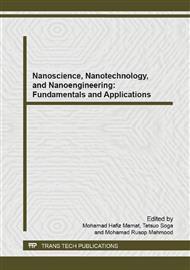p.1
p.6
p.11
p.15
p.20
p.25
p.30
p.35
Study of the Effect of Fluorine Doped Tin Oxide (FTO) Substrate on the Growth of Titanium Dioxide (TiO2) Nanorods via Hydrothermal Method
Abstract:
This paper explains on how to fabricate TiO2 on fluorine-doped tin oxide (FTO) substrate. The properties of FTO surface are electrically conductive, stable under atmosphere condition, chemically inert, mechanically hard, high temperature resistance and high tolerance to physical abrasion. This study focuses on growing titanium dioxide (TiO2) on FTO substrate. TiO2 is deposited onto FTO via hydrothermal method using hydrochloric acid (HCl), de-ionized water and titanium butoxide (TBOT) as precursor. The analyses are done on field emission scanning electron microscopy (FESEM), atomic force microscopy (AFM) and spectrophotometer (UV-Vis). The TiO2 grow on FTO substrate is showing uniformity and efficiency to be applied later in application of dye synthesis solar cells. Thus TiO2 can absorb the light and spread the electrons faster to produce electricity.
Info:
Periodical:
Pages:
11-14
Citation:
Online since:
June 2015
Keywords:
Price:
Сopyright:
© 2015 Trans Tech Publications Ltd. All Rights Reserved
Share:
Citation:


